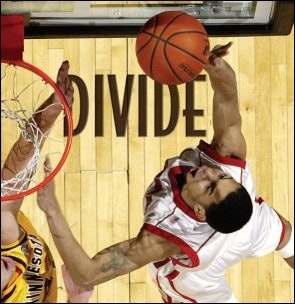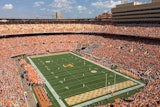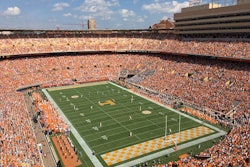For decades, indoor sports surfaces in North America have been marketed and manufactured to meet European standards -- but that may soon change

During his presentation at last spring's Maple Flooring Manufacturers Association conference, Paul Elliott had to backtrack 40 years in order to help his audience - representatives of North American wood athletic flooring manufacturers - understand the context of current standards for such surfaces. "And my history in the sports surface industry goes back only 12 or 13 years," says Elliott, whose skills as a researcher aided in his historical inquiry. (Elliott was formerly a research engineer at athletic flooring manufacturer Robbins Sports Surfaces and is now president of his own sports surface testing and engineering services company, ASET Services Inc.)
The goal of Elliott's seminar - titled "DIN 18032-2 Basics: What Are These Contraptions." - was to explain the testing methods used for the athletic surface standard developed in 1965 by the Otto Graf Institute (affiliated with Germany's University of Stuttgart). The DIN standards have gradually been accepted internationally as the paragon to which athletic surfaces are compared.
But toward the close of his presentation, Elliott raised a question of particular import to North American sports surfacing manufacturers: Why the reliance on a European standard for products manufactured on this continent?
For nearly two decades, since DIN 18032-2 was imported to North America from Germany, it's been a question often posed rhetorically, as both sports surfacing manufacturers and facility operators are largely satisfied with the status quo. "Part of the reason for the standard's acceptance is that many sports surfaces used in North America were developed in Europe, and had already been tested against the DIN standards," says Robert Johnston, principal of Victoria, B.C.-based CannonJohnston Architecture Inc., the only North American sports architecture firm with membership in the International Association for Sports Surface Science. "Serving almost like an international building code, this standard was embraced by the suppliers and manufacturers of wood athletic floors and quickly became the industry-wide benchmark against which all indoor sports floors would be - and still are - judged."
Another reason why North American manufacturers adopted the DIN standard by the mid-'80s is that some were looking to differentiate their wood floors from synthetic surfaces installed atop concrete surfaces. With the exception of a series of clarifications and one fundamental change in 1978 when a new test was added, the DIN standard hadn't been significantly altered since its inception in the '60s. However, the 1991 edition of the standard clearly defined for the first time separate sets of requirements for three different types of sports surface systems - area-elastic, point-elastic and combination - providing wood flooring manufacturers the differentiation they desired. (Generally speaking, area-elastic systems feature hardwood atop a resilient subfloor, point-elastic systems consist of synthetic material throughout all layers, and combination systems feature elements of both.)
Because the new standard tested six performance categories - force reduction, ball rebound, vertical deflection, surface friction, area indentation and rolling load - and assigned pass or fail marks to each, it was considered by most industry experts to be a fairly comprehensive measure of the most desirable qualities of an athletic surface. "Clients were happy with floors that met DIN, so the manufacturers were happy, too," says Elliott of the prevailing attitude, post-1991.
Then came the formation of the European Union in the late 1990s. In 2001, Germany issued a revision of DIN 18032-2, calling it a "pre-standard" with the hopes that it would eventually be adopted by the newly created Central European Norms committee. However, member nations of the EU could not immediately agree on the new standard (some countries have chosen to continue using the 1991 DIN standard, while others prefer following their own sports surface guidelines), and the stalemate continues to this day.
Meanwhile, on this side of the Atlantic, industry insiders began wondering if it was time for North American standard-setters like ASTM International to develop a comprehensive sports surface guideline exclusive to this continent. "Up until 2001, there wasn't anyone saying, 'Let's get an ASTM standard,' " says Elliott.
It was then that sports surfacing manufacturers began paying greater attention to the findings of testing labs such as Elliott's, which point out several reasons why North America should have a standard of its own.
First, the original intent of DIN 18032-2 was to ensure that all sports facilities in Germany meet minimum requirements. There, all sports surfaces are tested to see if they meet DIN requirements and, if they do, most floors then go on to be certified by standards officials as having met those guidelines. In North America, floor suitability testing is voluntary and field test certification is rare.
Second, according to the DIN standard, a rolling load of approximately 330 pounds applied to a playing surface is considered acceptable. But while such a load may be above and beyond the norms in Germany or Europe, North American floors are often required to support much heavier loads (think portable backstops and bleacher systems consisting of 10 rows or more).
Further, consider the fact that the makeup of a floor's top layer ultimately determines that surface's friction - one of DIN's six performance factors. In Europe, wood playing surfaces are commonly covered with oil-based urethane finishes. But in the United States, stricter environmental regulations are increasingly mandating the use of water-based finishes on wood athletic floors.
Finally, there is no statistical evidence to show that a floor designed to meet DIN recommendations is any safer than one that doesn't meet the European standard. "As to the DIN cutoffs for force reduction, area indentation and so on, those seem to be arbitrary numbers. I haven't seen any literature to prove otherwise," says Elliott. "To my knowledge, there isn't a study or article that says, 'This surface, if tested in X, Y and Z, is safer than this surface.' If you get injured in a game, you can't definitively say, 'I got injured because this floor didn't meet DIN standards.' I don't want to say that DIN isn't about safety - it is. I just don't think the scientific evidence is out there. I can't tell a client a floor that meets this part of DIN is safer than a floor that meets that part of DIN."
But if the DIN standard doesn't clearly define a sports surface's safety levels, what purpose does it serve?
Some say the standard is simply a marketing tool, created by European engineers but eventually adopted by North American sports surface manufacturers to move product. Such is the argument of Benno Nigg, a kinesiology professor and director of the Human Performance Laboratory at the University of Calgary. "Sports surface companies' major concern is marketing, not research and development," he charges, adding that the standards-making process "gives companies a level playing field, so that they're all able to sell. But it does not necessarily help develop a better product."
"As with any standard or code, the DIN standard for indoor sports surfaces has become the target standard of design," adds Johnston. "This fact generally limits product development, a circumstance not restricted to the sports surfacing industry, but also true in any industry that is legislated by building codes."
Neither circumstance is necessarily a bad thing for facility operators or architects, according to Elliott. "There's a plus to the DIN numbers. Say you went to Tom Jones High School, and its gym floor was okay but it didn't meet DIN standards. Then you went down the road to Jerry Jones High School, which had a softer floor that met DIN standards," he says. "Theoretically, as a facility operator you can say to the architect, 'Here's what the floor we liked felt like. We want a floor with these properties.' If you get a floor with similar properties, it should have a similar comfort level. DIN simplifies the selection process."
One area, in particular, in which floor specifiers look to the DIN standard to predict user comfort is force reduction - or as it's more commonly known, shock absorption. Presumably, a sports floor with a force reduction value of 60 percent absorbs 60 percent of the impact force and returns 40 percent to the athlete. A floor's ideal force reduction value will vary, depending on the sport. For example, basketball players - whose most common movements include running, jumping and sidestepping - might prefer a floor featuring a force reduction value close to or just below DIN's recommendation of 53 percent. The preferred floor of volleyball players, meanwhile, might have a bit more give (a force reduction value of, say, 60 to 70 percent), providing ideal conditions for jumping, diving and sliding. (Dancers and gymnasts would likely prefer floors with even more spring.)
Because volleyball and basketball players typically share gymnasium space with each other and a host of other sports and recreation participants, installing a sports surface that offers a happy medium is generally considered the best practice. Some people are probably going to think the floor's a little dead," says Elliott. "Others would probably like it to be a little softer."
Despite the difference in opinions, undoubtedly the goal of all athletes is to avoid injury. After all, maximum user comfort generally equates to minimum user injury, and joint stress is one of the leading causes of injury among basketball and volleyball players.
Nigg's Human Performance Laboratory has spent more than 20 years addressing this issue, although biomechanics researchers at the University of Calgary do so without relying on the DIN standard as a benchmark. "We work closely with companies to develop a product that is functional," says Nigg, whose lab has also been involved in the development of biomechanically correct athletic shoes manufactured by adidas. "It might not meet DIN norms, but it is functionally better."
Given his biomechanics expertise, the expectation is that Nigg's sports surface research focuses on the user's joints and not any other parts of the body. But in Nigg's opinion, it doesn't make sense for anyone to study the harmful effects of head-on-wood impacts, for example, because "head injuries are so infrequent on these types of surfaces."
Elliott has seen the numbers that prove as much. "We looked at 10 years of statistics from the NCAA for basketball and volleyball," says Elliott, who also serves on the ASTM Subcommittee F08.52 on Miscellaneous Playing Surfaces, an offshoot of the larger Committee F08 on Sports Equipment and Facilities. "There were some concussions, but no fatalities. We're a safety organization, and if there were enough serious head injuries, we would have used the F355 test for wood floors."
As far back as the 1980s, there has been talk of applying to indoor sports surfaces the ASTM F355 impact test, which uses a steel missile to test the G-max value of a surface and has already been used for playgrounds and sports turf fields (see "Shock Value," Sept. 2002, p. 54). However, North American wood floor manufacturers decided against adopting the test after realizing it would be impossible to regularly administer in facilities without damaging wood athletic floors.
"The difficulty in setting standards for basketball floors or multiuse floors is that most of these floors aren't shock-attenuating surfaces," says Martyn Shorten, chairman of the F08 committee and managing principal of BioMechanica LLC, a Portland, Ore.-based sports surface research and engineering firm.
Despite those challenges, it now appears that the ASTM standard setters are poised to tackle the issue. In 2001, the F08 committee approved the F2117-01 Standard Test Method for Vertical Rebound Characteristics of Sports Surface/Ball Systems; Acoustical Measurement, which assigns a quantitative measurement to the vertical rebound produced during impacts between athletic balls and athletic surfaces. "The ball rebound test gives us some good numbers," says Elliott, who chaired the task force charged with developing the standard. "It does a pretty good job of preventing dead floors."
ASTM's next endeavor is to develop a testing method for force reduction on sports surfaces. A drafting session for the new standard was scheduled for the F08 Technical Committee's spring meeting, held in mid-May. According to Shorten, there's a possibility the new force reduction testing method will be designed to apply to both indoor and outdoor sports surfaces, including tennis courts and running tracks.
The response from the sports surface industry? "Arguably, it is long past the time when the DIN standard should be superceded by a new standard that reflects current design and usage demands," says Johnston.
Whether the future holds further and more wide-reaching North American standards development is anybody's guess, including Elliott's. "What's next with all of these standards? Do we want to go with one for rolling load or area indentation? I don't know," he says, adding that the speed at which ASTM develops new sports surface standards ultimately depends on the market's demands. "If someone came to us with an urgent need and said, 'I'm running through floors left and right,' we could probably get something out within two years. If the standards are worth developing, on the other end there has to be people using them, otherwise the folks at ASTM are just spinning their wheels."
Yet should new North American sports surface standards appear by 2006 - or perhaps sooner - it may take manufacturers longer than that to adjust. "It'll probably be two or three years before all of the mills, or a significant portion of them, are ready to change their marketing strategies. I hope I'm wrong on that," says Elliott of the assumed shift from adherence to DIN guidelines to those written by ASTM. "It's kind of like sending someone to see if the water's hot or cold - nobody likes to dive in headfirst."




































